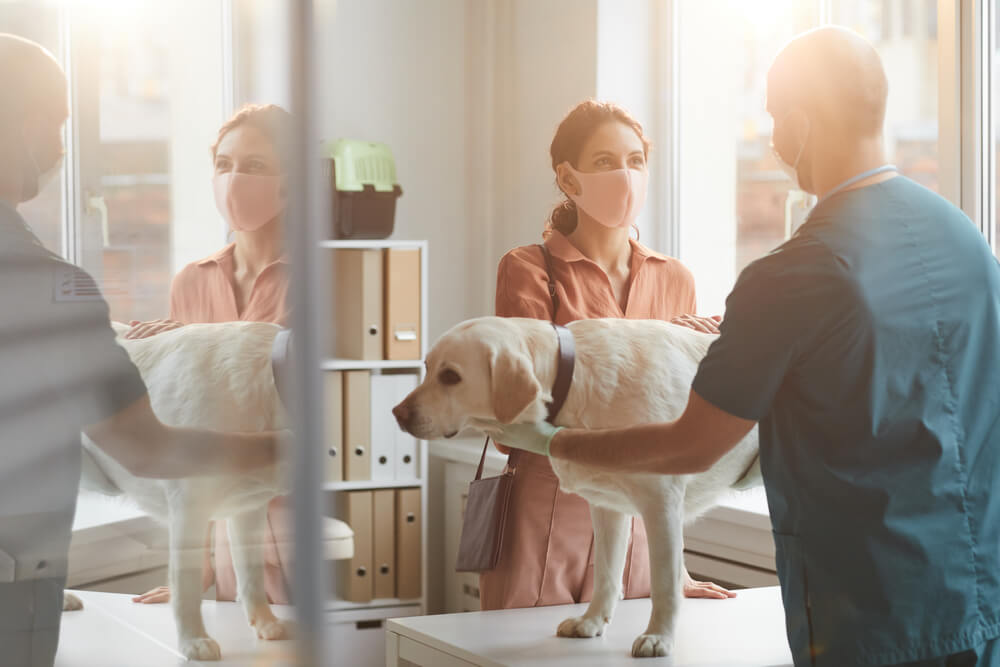
Were you frustrated by your long wait to schedule your pet’s last veterinary appointment? Veterinarians are overloaded right now, which has increased wait times to see a veterinary professional. Our team at Towne Centre Animal Hospital wants to explain what issues are causing veterinarians to be so overwhelmed.
Pandemic protocols decreased veterinary productivity
When COVID-19 flexed its viral muscles, causing a nationwide shutdown, veterinarians had to quickly adapt to continue to provide care for their patients. Measures, including curbside appointments and sanitizing all surfaces between each patient, were employed to protect our staff and clients during this difficult time. While these steps were necessary to decrease the infection risk, they greatly hampered our efficiency and productivity. Every appointment took longer, because our veterinary technicians had to go back and forth between the parking lot and the clinic treatment room, and veterinarians had to make a phone call to deliver the necessary information to the pet owner. In addition, time was needed between visits to properly disinfect the treatment room and other surfaces in the hospital. An American Veterinary Medical Association (AVMA) census showed that veterinarians’ productivity declined by about 25% in 2020 compared with 2019, greatly decreasing the number of pets we could see per day.
Decreased productivity led to a veterinary work backlog
Since fewer patients could be seen per day, pets requiring urgent attention had to be prioritized, to ensure they received the care they needed. This caused postponement of routine appointments, such as wellness visits, vaccinations, dental cleanings, and spay and neuter procedures. Once COVID-19 lightened its grip on the world, we had to start rescheduling these canceled appointments, while also seeing new appointments. There are only so many hours in a day, and while we are striving to ensure every pet gets the attention they deserve, we can’t always do this in as timely a fashion as we did pre-pandemic.
Veterinary visits are increasing
Pet owners are taking better care of their pets, and seeking veterinary care more frequently. They are also willing to provide more expensive services and products for their four-legged family members. The average number of appointments increased by 4.5% from 2019 to 2020, and by 6.5% from January to June 2021, compared with the same period in 2020. Improved veterinary care is always a positive development, and these numbers would indicate healthy growth in a normal year. However, when combined with the other challenges that veterinary professionals face, these increased appointments contribute to veterinary overload.
Veterinary practices are experiencing staffing shortages
Staffing shortages were a problem for veterinarians before the pandemic, and havoc wreaked by the virus exacerbated the issue. Reasons for staffing shortages include:
- The virus — Veterinary professionals worked on the front lines during the height of the pandemic, causing exposure to COVID-19. These individuals were forced to take time off to recover from illness, and to protect their co-workers from infection.
- Child care — The shutdown caused many challenges for parents who suddenly had to find child care. In some cases, this meant cutting back work hours, or taking a leave of absence to ensure their children received the attention they needed.
- Burnout — Many people don’t realize that veterinary medicine is an extremely demanding and stressful field. Female veterinarians are 2.4 times as likely, and male veterinarians are 1.6 times as likely, to take their own life than the general public. In addition, male veterinary technicians are five times as likely, and female veterinary technicians are 2.3 times as likely, to take their own life than the general public. These findings were demonstrated in a study performed before the pandemic, and COVID-19 has only added to these individuals’ stress and compassion fatigue.
- Mental health — People who choose to become veterinary professionals are typically extremely empathetic, with a tendency toward perfectionism. This combination, along with having to cope with cases that end disappointingly, can lead to severe emotional distress. Many veterinary professionals feel forced to take steps to preserve their mental health, meaning they may cut back hours, or decide to find an entirely new, less demanding, and less stressful career. These shortages can be difficult to fill in a prompt manner, leaving other team members to work longer hours.
Pet owners can help our veterinary team members

Our top priority is ensuring you and your pet receive the attention and care you deserve, and we would appreciate your help in achieving this goal. Steps that would help as we find ways to mitigate veterinary overload include:
- Thinking ahead — Schedule your pet’s routine visits well in advance, to ensure their wellness visit, vaccinations, and preventive care does not lapse.
- Monitoring closely — Monitor your pet closely for any behavior or habit changes, so that potential health issues can be addressed before they become a serious problem.
- Expressing empathy — Be patient with and express empathy to our veterinary staff during this difficult time. We understand your frustration with the longer waits for appointments, but we are working as hard as we can to ensure every pet who needs attention receives the care they deserve.
We greatly appreciate your patience and understanding as we strive to ensure every pet is treated appropriately. If you would like to schedule a routine appointment for your pet, contact our team at Towne Centre Animal Hospital, so we can find a time that is convenient for you.
